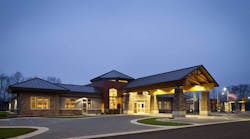Improving Native American Healthcare Through Design
Health disparities abound when it comes to Native Americans versus other Americans in the US.
They can be found in these numbers from the Indian Health Service (IHS), a federal government agency that provides health services to 2.2 million of the nation’s estimated 3.7 million American Indians and Alaska Natives. According to IHS, American Indians:
- Die at higher rates in many categories, including unintentional injuries, homicide, suicide, cirrhosis and diabetes
- That are born today have a life expectancy that is 5.5 years less than the rest of the population
Why is it this way? It’s a layered answer that involves lack of education, poverty and a history of discrimination Native Americans face when seeking out health services.
“Native American healthcare is in a state of crisis today, because many tribal citizens hesitate to engage providers as a result of generations of discrimination and abuse by the medical community,” explains Seven Generations Architecture + Engineering’s director of architecture Steven VandenBussche.
To facilitate better outcomes for tribal citizens, Seven Generations works to combine purposeful design with collaboration amongst key groups. It’s a strategy the tribally owned firm used when planning the initial design for a new, unified IHS location at the Rapid City Clinic in South Dakota.
A New Kind of Facility
For the new IHS outpost, Seven Generations worked with Sheila Cahnman, president of JumpGarden Consulting. The goal was to create a welcoming, culturally sensitive health care facility.
“Specific colors, patterns and symbols that differ from tribe-to-tribe are critical components of design in Native [American] medical facilities that build trust,” explains Cahnman. “Holistic treatment that incorporates cultural-based practices is impactful.”
The two firms also worked closely with representatives from three surrounding reservations – Cheyenne River, Pine Ridge and Rosebud – as well as with the community through public forums.
“There’s a certain amount of trust-building that has to happen,” VandenBussche says. “The only way to do that is to listen to folks, listen to their stories. We did our best to address concerns, including how to make the building accessible. It’s essentially on top of a hill. We looked at ways to get a bus route and other transit out there. Once we were in the building, we wanted to make it easy for folks to find the service they need, where they need to go. Open and easy-to-navigate public areas was really important.”
Other thoughtful design elements in the plans for the new Rapid City IHS include:
Geographical features of the different tribes. From black hills to plains to grasslands, the Seven Generations team wanted to incorporate design elements that resemble the characteristics of the different tribal reservations.
For example, the Oglala Lakota people, who reside on the Pine Ridge Indian Reservation, are particularly connected to the stars and the sky, VandenBussche says. So plans include a large skylight that’s patterned after star symbols the Lakota used in past days to navigate. “We tried to be conscious of colors and other things that are of value to them,” VandenBussche adds.
Flexible spaces. “We thought about developing flexible spaces, so if services change over the years, it’s easy to adapt that space,” VandenBussche says. “What we find in a lot of tribal healthcare clinics is the services change based on the demands of the tribes. They might have a spike and need for one type of service. A lot of these folks have never had any healthcare. It’s one thing to be proactive – and another to be reactive.”
Spaces for cultural-based medicine. When designing for Native American healthcare facilities, VandenBussche says it’s important to integrate cultural-based medicine in a way that’s sensitive and respectful. In plans for the Rapid City IHS, sweat lodges are incorporated within the property.
A Better Future
For the 573 federally recognized tribal nations in the US, it’s likely that positive healthcare experiences do not come easily. But thoughtful design and easy access to the healthcare facilities surrounding them is a step in the right direction.
VandenBussche advises designers to keep in mind that designing for tribal needs, including healthcare facilities, requires consensus from the users themselves, not just executives.
“There’s typically about a 100% consensus required among the tribal community. Some healthcare architects don’t understand that,” he explains. “It becomes a community project more than anything.”
While you're here...
Top 9 Design Trends Spotted at HD Expo 2019
3 Workplace Privacy Pods You’ll Want to Use
